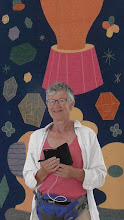A novel in sonnet form, published in 1986, about several people in San Franciso and the area.
We meet John who works in armaments, and his college mate Phil who has given up his high-flying job for reasons of principle, after his wife has left him with their seven-year-old son. There's the Dorati family, wine growers in Sonoma County, and their three grown-up children, Liz the high-powered lawyer, Sue the international cellist, and Ed who is gay, but can't reconcile it with his Christianity.
Then another friend of all of these, Jan the sculptor with her two Siamese cats, Cuff and Link. The story covers love, gay and straight, friendships, families, birth and death and politics.
And California is another living character in the book - the city with its clubs , cafés and galleries, and in contrast, the natural and cultivated world, whales off the coast, gardens, the vineyard.
A brilliant book, easy to read, light in touch, and as sparkling as the San Francisco air.
As soon as I'd finsihed this one, I picked it up and started reading it again, and am enjoying the witty allusions to other poets too. Marvell, and Belloc for starters.
Tuesday, August 5, 2008
Saturday, August 2, 2008
Smith, Betty - A Tree grows in Brooklyn
I've just re-read this book about a girl growing up in early 20th century Brooklyn. Full of details of everyday life.
The tree of Heaven, the sumac, that tough weed of a tree which shoots out suckers everywhere, indestructible. The kind you find growing up from neglected backyards, reaching for the sky.
Interesting thoughts on writing, truth, lies and imagination. I'll copy them in later. And a great story too.
Gently, Teacher explained the difference between a lie and a story. A lie was something you told because you were mean or a coward. A story was something you made up out of something that might have happened. Only you didn’t tell it like it was; you told it like you thought it should have been.
Francie always remembered what that kind teacher told her. ‘You know, Francie, a lot of people would think that these stories that you’re making up all the time were terrible lies because they are not the truth as people see the truth. In the future, when something comes up, you tell exactly how it happened but write down for yourself the way you think it should have happened. Tell the truth and write the story. Then you won’t get mixed up.’
It was the best advice Francie ever got. Truth and fancy were so mixed up in her mind – as they are in the mind of every lonely child – that she didn’t know which was which. But Teacher made these things clear to her. From that time on, she wrote little stories about things she saw and felt and did. In time, she got so that she was able to speak the truth with but a slight and instinctive coloring of the facts.
Francie was ten years old when she first found an outlet in writing. What she wrote was of little consequence. What was important was that the attempt to write stories kept her straight on the dividing line between truth and fiction.
If she hadn’t found this outlet in writing, she might have grown up to be a tremendous liar.
The tree of Heaven, the sumac, that tough weed of a tree which shoots out suckers everywhere, indestructible. The kind you find growing up from neglected backyards, reaching for the sky.
Interesting thoughts on writing, truth, lies and imagination. I'll copy them in later. And a great story too.
Gently, Teacher explained the difference between a lie and a story. A lie was something you told because you were mean or a coward. A story was something you made up out of something that might have happened. Only you didn’t tell it like it was; you told it like you thought it should have been.
Francie always remembered what that kind teacher told her. ‘You know, Francie, a lot of people would think that these stories that you’re making up all the time were terrible lies because they are not the truth as people see the truth. In the future, when something comes up, you tell exactly how it happened but write down for yourself the way you think it should have happened. Tell the truth and write the story. Then you won’t get mixed up.’
It was the best advice Francie ever got. Truth and fancy were so mixed up in her mind – as they are in the mind of every lonely child – that she didn’t know which was which. But Teacher made these things clear to her. From that time on, she wrote little stories about things she saw and felt and did. In time, she got so that she was able to speak the truth with but a slight and instinctive coloring of the facts.
Francie was ten years old when she first found an outlet in writing. What she wrote was of little consequence. What was important was that the attempt to write stories kept her straight on the dividing line between truth and fiction.
If she hadn’t found this outlet in writing, she might have grown up to be a tremendous liar.
Subscribe to:
Comments (Atom)
